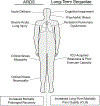The long-lasting effects of the acute respiratory distress syndrome
- PMID: 32168460
- PMCID: PMC7454121
- DOI: 10.1080/17476348.2020.1743182
The long-lasting effects of the acute respiratory distress syndrome
Abstract
Introduction: Acute respiratory distress syndrome (ARDS) is a severe form of acute lung injury common in critically ill patients and characterized by significant morbidity and mortality. It frequently manifests long-lasting effects beyond hospitalization, from cognitive impairment to physical weakness.Areas covered: Several complications of ARDS have been identified in patients after hospital discharge. The authors conducted literature searches to identify observational studies, randomized clinical trials, systematic reviews, and guidelines. A summary of is presented here to outline the sequelae of ARDS and their risk factors with a focus on the limited but growing research into possible therapies. Long term sequelae of ARDS commonly identified in the literature include long-term cognitive impairment, psychological morbidities, neuromuscular weakness, pulmonary dysfunction, and ongoing healthcare utilization with reduced quality of life.Expert opinion: Given the public health significance of long-term complications following ARDS, the development of new therapies for prevention and treatment is of vital importance. Furthering knowledge of the pathophysiology of these impairments will provide a framework to develop new therapeutic targets to fuel future clinical trials in this area of critical care medicine.
Keywords: acute respiratory distress syndrome; long-term outcomes.
Figures


References
-
- Ashbaugh DG, Bigelow DB, Petty TL, et al. Acute respiratory distress in adults. Lancet. 1967;2(7511):319–323. - PubMed
-
- Ranieri VM, Rubenfeld GD, Thompson BT, et al. Acute respiratory distress syndrome: the Berlin definition. Jama. 2012;307 (23):2526–2533. - PubMed
-
- Rubenfeld GD, Caldwell E, Peabody E, et al. Incidence and outcomes of acute lung injury. N Engl J Med. 2005;353(16):1685–1693. - PubMed
-
- Bellani G, Laffey JG, Pham T, et al., Epidemiology, patterns of care, and mortality for patients with acute respiratory distress syndrome in intensive care units in 50 countries. JAMA. 2016;315(8):788–800. - PubMed
- • Study outlining the important epidemiology and trends for ARDS internationally.
Publication types
MeSH terms
Grants and funding
LinkOut - more resources
Full Text Sources
